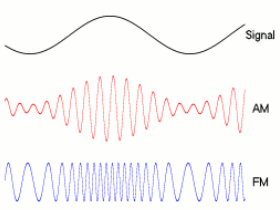ddd
AM – (Amplitude Modulation)
FM – (Frequency Modulation)

ASK – (Amplitude Shift Keying)

FSK (Frequency Shift Keying)

GFSK
GFSK stands for Gaussin Frequency Shift Keying modulation. In GFSK, baseband pulses (consists of -1 and 1) are first passed through the gaussian filter before modulation. This makes pulses smooth and hence limit the modulated spectrum width. This process is known as pulse shaping.
2GFSK
In 2GFSK two different frequencies are used, depending on whether the data that will be transmitted is a 1 or a 0. To transmit a 1, the carrier frequency is increased by a certain deviation. Zero is encoded by decreasing the frequency by the same deviation. See the figure below.
In real-world systems, the frequency deviations from the carrier are much smaller; the figure is deliberately exaggerated to show how the encoding works.

4GFSK – 4-Level GFSK
Using a scheme such as this, there are two ways to send more data: use a higher symbol rate or encode more bits of information into each symbol. 4-level GFSK (4GFSK) uses the same basic approach as 2GFSK but with four symbols instead of two. The four symbols (00, 01, 10, and 11) each correspond to a discrete frequency, and therefore 4GFSK transmits twice as much data at the same symbol rate. Obviously, this increase comes at a cost: 4GFSK requires more complex transmitters and receivers.
PSK (Phase Shift Keying)

OOK – (On-Off Keying)

MSK – (Minimum-Shift keying)

